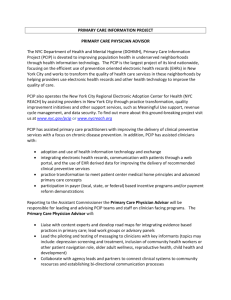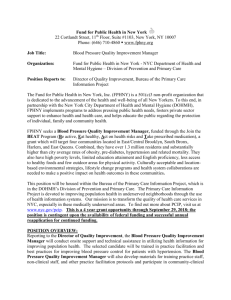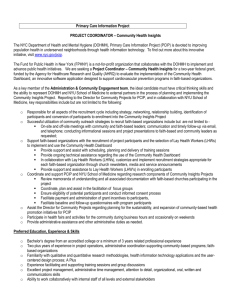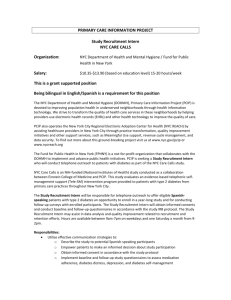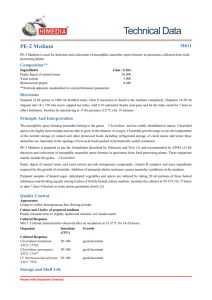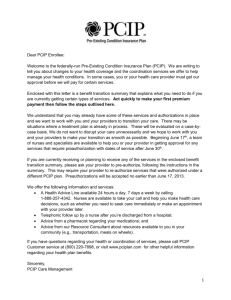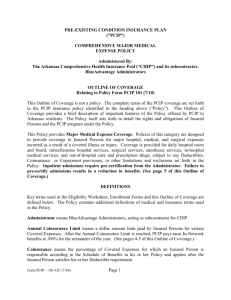Using Health Information Technology to Improve The Primary Care Information Project
advertisement
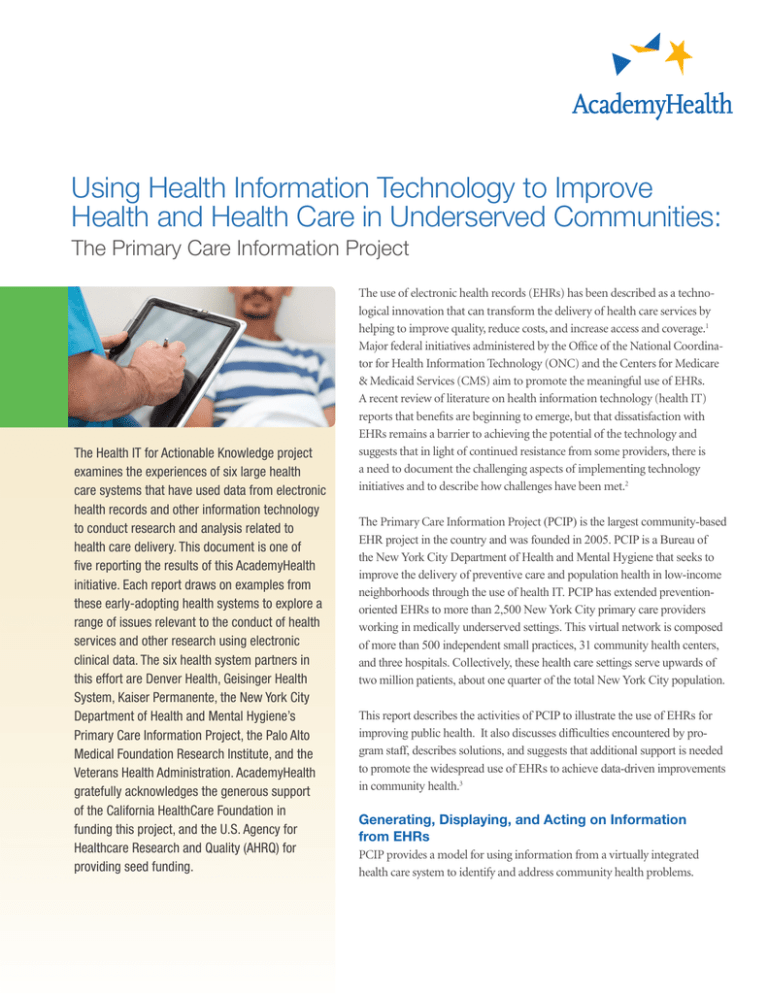
Using Health Information Technology to Improve Health and Health Care in Underserved Communities: The Primary Care Information Project The Health IT for Actionable Knowledge project examines the experiences of six large health care systems that have used data from electronic health records and other information technology to conduct research and analysis related to health care delivery. This document is one of five reporting the results of this AcademyHealth initiative. Each report draws on examples from these early-adopting health systems to explore a range of issues relevant to the conduct of health services and other research using electronic clinical data. The six health system partners in this effort are Denver Health, Geisinger Health System, Kaiser Permanente, the New York City Department of Health and Mental Hygiene’s Primary Care Information Project, the Palo Alto Medical Foundation Research Institute, and the Veterans Health Administration. AcademyHealth gratefully acknowledges the generous support of the California HealthCare Foundation in funding this project, and the U.S. Agency for Healthcare Research and Quality (AHRQ) for providing seed funding. The use of electronic health records (EHRs) has been described as a technological innovation that can transform the delivery of health care services by helping to improve quality, reduce costs, and increase access and coverage.1 Major federal initiatives administered by the Office of the National Coordinator for Health Information Technology (ONC) and the Centers for Medicare & Medicaid Services (CMS) aim to promote the meaningful use of EHRs. A recent review of literature on health information technology (health IT) reports that benefits are beginning to emerge, but that dissatisfaction with EHRs remains a barrier to achieving the potential of the technology and suggests that in light of continued resistance from some providers, there is a need to document the challenging aspects of implementing technology initiatives and to describe how challenges have been met.2 The Primary Care Information Project (PCIP) is the largest community-based EHR project in the country and was founded in 2005. PCIP is a Bureau of the New York City Department of Health and Mental Hygiene that seeks to improve the delivery of preventive care and population health in low-income neighborhoods through the use of health IT. PCIP has extended preventionoriented EHRs to more than 2,500 New York City primary care providers working in medically underserved settings. This virtual network is composed of more than 500 independent small practices, 31 community health centers, and three hospitals. Collectively, these health care settings serve upwards of two million patients, about one quarter of the total New York City population. This report describes the activities of PCIP to illustrate the use of EHRs for improving public health. It also discusses difficulties encountered by program staff, describes solutions, and suggests that additional support is needed to promote the widespread use of EHRs to achieve data-driven improvements in community health.3 Generating, Displaying, and Acting on Information from EHRs PCIP provides a model for using information from a virtually integrated health care system to identify and address community health problems. Three key design principles working in concert drive the activities of PCIP: •Information at the point of care or during the time of the patient visit; • Information that is integrated into the natural workflow of the practice and allows providers to use the information to manage populations of patients’ health; and • Feedback loops that align with reimbursement or incentives so that improvement efforts can be sustained across populations.4 In addition, there is great potential to use PCIP data to help characterize, monitor, and affect the health of communities and to enhance the health department’s ability to diagnose and investigate health problems, disparities, and health hazards in the community. PCIP, for example, has the potential to conduct syndromic surveillance for certain conditions in outpatient settings. The health department plans to integrate syndromic surveillance data from PCIP practices into its regular influenza-like illness (ILI) surveillance as part of the the U.S. Centers for Disease Control’s ILINet Program. The data will be used both locally and nationally to track the weekly incidence of ILI during influenza season. The provision of ILI syndromic data from practices requires no active role by practitioners. Automated queries will generate the count data for ILI encounters and total encounters, stratified by date and age group. The system will provide these data to the health department when patients are seen so that trends in ILI may be identified and guide public health responses. Syndromic data generated from practices working with PCIP can provide information from the clinical setting that adds to existing public health reporting through laboratory testing, mandatory communicable disease reports, or other surveillance.5 Improving the Delivery of Ambulatory Services PCIP is a dynamic program, which not only helps practices develop data reporting capabilities, but also strives to find new uses for the data to inform, educate, and empower physicians and patients. Point of Care Decision Supports for Practitioners PCIP’s Clinical Decision Support System (CDSS) identifies opportunities for clinical preventive services in real time at the point of care.6 The system is programmed to evaluate clinical data as they are entered into the EHR during the patient visit and, taking information such as age, diagnosis, medications, vital signs, or lab results into account, determine whether patients are eligible for specific preventive services. If the patient has not yet received a service, a clinical decision support alert is displayed with a number of options for actions. The actions are based on recommendations from the U.S. Preventive Services Task Force and quality measures developed by the National Committee for Quality Assurance (NCQA) and endorsed by the National Quality Forum (NQF).7 New York’s Citywide Health Agenda Guides PCIP Activity Since 2004, the New York City health department has been proactively measuring the health of its residents through indicators established by the agency. “Take Care New York,” (TCNY) the city’s health policy agenda, was established to monitor the top 10 priority health areas that present the greatest disease burden to New Yorkers and have high potential for improvement through clinical intervention. These areas include cardiovascular health; diabetes; smoking; establishing a regular health care provider; HIV testing and treatment; cancer screening; immunizations; depression screening and treatment; alcohol and substance abuse screening and treatment; and appropriate treatment of asthma.9 In addition, to further focus providers on key actions, a core set of cardiovascular care measures was established as the city’s highest priority for improvement.10 PCIP’s goals are guided by TCNY as is the selection of quality measures embedded in the EHR and used by primary care practices. A total of 34 adult primary care prevention reminders are programmed into the Clinical Decision Support System used in PCIP practices. Clinicians can act on the reminder with “one click” to order diagnostic tests, prescribe recommended medications, intervene with advice or further counseling, or print out patient education materials. They can also “snooze” the reminder to a later point when a patient is more likely to be engaged in the recommended service or select “never remind” if there is a clinical contraindication for the guideline.8 PCIP has demonstrated an increase in the delivery of recommended clinical preventive services when physicians see reminders in the EHR and understand how to use them. Program data show improvement in the delivery of clinical preventive services among participating providers, with increases in rates of aspirin therapy for patients with ischemic vascular disease or diabetes, control of blood pressure for patients with hypertension, and smoking cessation interventions for patients who smoke. Example 1 reproduces a typical report given to providers. Quality Measurement and Improvement Feedback for providers is available on a monthly basis from “dashboards,” which focus on patient populations and trends. An example is reproduced here on pages 8 and 9. PCIP providers receive emailed PDF copies of dashboards which include graphic displays of performance on EHR utilization and quality measures. Utilization measures pertain to the use of EHR system features. Quality measures look at patient health statistics. Table 1 lists the measures included on the dashboards. Though currently less than 2 Table 1: Measures Displayed in the Provider Dashboard Utilization Measures Quality Measures (Percent of records qualifying for each measure) (Percent of records showing that each measure is documented for the relevant group) Office visits recorded Locked notes for visits Blood pressure entered Current meds reviewed Allergy information in structured format Electronic prescribing used11 Order sets used Average appointment time reported Labs created Labs reviewed Control of glycated hemoglobin (A1C), a common biological marker for diabetes Blood pressure controlled in patients with hypertension Cholesterol screening for patients without diabetes or ischemic vascular disease BMI measured Smoking status taken Smoking cessation offered to smokers Sexual history taken Mammogram done HIV screening done Primary caregiver assigned half of providers working with PCIP receive these dashboards, PCIP is working to ensure that all providers by the end of 2011 receive monthly dashboards. The dashboards allow physicians to view aggregate information on all of their patients and to see how they are performing relative to other PCIP providers. Data on each metric are shown as a simple trend line based on the past six months, with an overlay of average trends of similar practices. The “at a glance” format allows practices to quickly identify where they need to make changes to improve their percentages. Specific recommendations based on the results of the report are highlighted to help practitioners focus on measures that need improvement. The data are analyzed and used to deploy PCIP field staff who work with providers to help them use EHRs more effectively. PCIP also maintains a wiki page that features common problems and solutions identified by PCIP staff. Promoting Preventive Care PCIP has used EHRs as a means to implement pilot pay-for-quality programs. Two programs were created to help drive the focus on clinical services that have the most potential to reduce preventable deaths in New York City. Health eHearts offers financial incentives to practices for performance on four key cardiovascular care areas, tracked using EHRs: antithrombotic therapy, blood pressure control, cholesterol control, and smoking cessation intervention. Half of the participating physicians receive monetary incentives for each patient that reaches a set target and incentives are greater for patients that are harder to treat.12 All physicians receive performance reports on a quarterly basis. Preliminary first year results indicate that all practices demonstrated some improvements across the measures. Antithrombotic therapy and blood pressure control showed little improvement, smoking cessation intervention showed the least improvement, and cholesterol control showed no improvement. Whether incentives assisted in driving improvement is not yet clear. In another pilot, Health eQuits, participating practices established a baseline rate of smokers receiving a cessation intervention. Practices are paid for each additional patient receiving a documented cessation intervention above baseline. Health eQuits is a pay-for-improvement design, with the goal of increasing the delivery of cessation intervention to an additional 18,000 smokers. In both pilots, providers at the practices have access to patient-specific data through a quality reporting tool and they receive trended summary reports derived from their EHR data. Another strategy for promoting preventive care, the Panel Management Program, offers a shared resource for small practices that do not have the capacity to conduct outreach to at-risk patients on their own.13 With EHRs, practice outreach specialists have the ability to run queries to identify patients with chronic conditions who have not seen the doctor and have not met recommended treatment goals for several chronic conditions, for example, control of blood pressure for patients with hypertension. PCIP outreach specialists call patients and encourage them to make appointments for monitoring and care. Outreach specialists make calls on behalf of the practice and work with the providers and practice staff to identify their priority patients.14 Challenges and Solutions Support from the New York City mayor, the health commissioner, and other high-level policymakers as well as strong program leadership, a committed staff, and dedicated funds to establish and operate PCIP are all factors that contribute to the program’s success. Another is that data-driven decision-making is a core program principle. This includes ongoing inspection of day-to-day processes to identify problems to correct and successes on which to build. 3 Promoting Provider Participation Convincing providers to adopt and utilize EHRs to promote population health requires substantial education and training. Small practices have staff and time constraints. Practitioners may be reluctant to make even modest financial investments or to take time to learn a new system. They have questions about patient privacy and also may be wary of sharing data that could be used to rate their performance. PCIP has employed multiple recruitment and retention strategies to address these challenges. The project worked with community leaders to identify and engage practices. Monetary incentives and rebates were available to practices associated with certain health plans or neighborhoods, and PCIP used educational programs, software demonstrations, and emails containing program literature to generate interest.15 PCIP provides tremendous support during the implementation phase and continues to provide on-site consulting after implementation to address billing and reporting issues, to ensure that data are recorded and reported in an optimal manner, and to address problems that may occur related to data transmission. PCIP staff emphasize the relationship between high quality data entry and documentation and providers’ ability to use the information later to care for patients, to generate reports for payment, and to demonstrate that they qualify for performance-based rewards. From 2011 until 2016, physicians are eligible for financial bonuses from Medicare and Medicaid if they can demonstrate that they are making “meaningful use” of EHRs. Regulations issued by the U.S. Department of Health and Human Services specify meaningful use requirements and technical standards for certified EHR systems. PCIP now oversees NYC REACH, one of the Regional Extension Centers funded under the Health Information Technology for Economic and Clinical Health (HITECH) Act and is charged with helping physicians make the transition to using EHRs and meeting meaningful use standards. The program dashboards show providers their progress on the standards and measures required by CMS to qualify for meaningful use incentives. PCIP staff members are available to help providers meet the requirements through coaching and assistance with troubleshooting software or workflow issues. Similarly, working with PCIP, more than 100 primary care sites have met NCQA standards to be recognized as patient-centered medical homes and therefore, may be eligible for enhanced reimbursement or incentives through New York State Medicaid or other health plan programs. Protecting Privacy Data currently transmitted from practices to PCIP are limited to summarized counts of patients or events by provider. PCIP does not have access to patient-level data and practice-specific information is not shared among institutions. At the practice, PCIP staff train providers on their EHR system features to help protect the integrity of their records. These include electronic availability of privacy notices and signed consent forms, the encryption of patient data, role-based access (which allows each practice to determine what information each staff member can see or use), and the capacity to track and record activity each time a patient record is viewed. PCIP is dedicated to collecting summary-level statistics only for specific public health uses and, as a matter of practice, does not collect patient-level data in order to protect patient privacy.17 Assuring Data Quality For a program that promotes data-driven decision-making, data quality must be a primary concern. Yet, practices’ use of EHRs is highly variable, particularly when they enter the program. Factors such as differences in workflow, hardware selection, and experience or comfort with information technology contribute to the variation. PCIP has field staff members that are experts in customizing the EHR interface and helping providers become more efficient with the software. However, most providers do not know to ask for help. Therefore, using summarized data that are transmitted to PCIP, a “super score” is calculated for each to detect the presence of five use and five quality measures for adult patients (see Table 2). The scores indicate which practices are succeeding or struggling. They are used to set priorities for on-site assistance from PCIP staff. Customization might include building templates specific to the practice to minimize “clicking” for entering patient information; detecting broken health information linkages, for immunization or laboratory results; and mapping of billing or laboratory codes. To date, the super score is generated for more than 400 practices. In a typical month, 80 practices receive visits from PCIP staff to help with the EHR use. Incentives for Physicians Recruiting and retention efforts for PCIP have succeeded in part because the program offers tools and opportunities not only to practice more effectively and efficiently, but also to be rewarded for positive changes such as providing more preventive services. In addition to piloting pay-for-prevention programs, PCIP staff have worked with the Health Care Incentives Improvement Institute, an organization that develops standardized score cards. In collaboration with the Institute’s Bridges to Excellence program, PCIP developed the Adult Primary Care Recognition Program scores for practitioners. This score card uses data aggregated from EHRs by PCIP, and with permission from the providers, transmits the necessary summaries to BTE for scoring. Providers that meet the scoring requirements are publicly recognized. The provider’s recognition status is shared with insurers or employers to determine eligibility for financial rewards or quality distinctions that they may offer.16 4 Table 2: Components of the Super Score Electronic Health Records Use Measures Quality Measures (Percent of records qualifying for each measure) (Percent of records showing that each goal has been achieved for the relevant group) Recording current procedural terminology (CPT) code Blood pressure control in hypertensive patients Electronic prescribing Mammography screening Laboratory results reviewed Control of glycated hemoglobin (A1C), a common biological marker for diabetes Current medications reviewed Allergy information in structured format Understanding that any new data source needs to be tested for its reliability, PCIP undertook a manual review of EHRs from PCIP practices to assess the frequency of documentation across quality measures. The study results indicate that with the exception of a few measures, there is high variation across practices. Variation may be attributed to documentation habits by providers or may occur when the EHR software does not interpret data, for example, because certain terms are not recognized or because data elements are in locations in the record that are not recognized by the software for reporting purposes. These findings suggest that automated quality measurement may underestimate the delivery of clinical preventive services. They also point to a need for ongoing training and feedback for providers and for continuous monitoring of EHR systems to ensure that reported data are captured and reported appropriately. Technical Assistance from PCIP: Development of a Master Lab Compendium Differences in the completeness of coding across laboratories was one early problem that PCIP encountered. To ensure that each laboratory company’s compendium is appropriately coded for clinical quality measurement, PCIP partnered with all major New York City lab companies to develop a master lab compendium. The compendium is used for PCIP EHRs, thus enabling a common standard by which to conduct lab reporting and clinical decision support. While a comprehensive consideration of the challenges and lessons from PCIP’s development of the laboratory compendium is beyond the scope of this report, this brief summary provides a window into one of the complexities faced in gleaning analytically useful information from electronic data aggregated from multiple sources. Creating the compendium required considerable resources and is specific to New York City’s PCIP. It may not be compatible with other programs or jurisdictions. Similarly, case definitions for various conditions may differ from system to system making consistent detection, reporting, and analysis of case data difficult.18 Smoking status assessment Influenza vaccinations for patients 65 or older Working Toward System Compatibility and Standards As PCIP has grown and more vendors participate, and as PCIP data are used for a variety of programs and purposes, issues such as how data fields are set up, how data are reported and transmitted, and how measures are interpreted must be addressed. PCIP experiences, including the current tasks associated with being a Regional Extension Center, suggest that there is a need for national leadership to help develop specifications to promote interoperability among systems to support broader information exchanges within communities and on a national basis. There is a particular advantage in developing specifications for the reporting, exchange, and use of EHR data for public health purposes. Such an effort would help public health agencies make better use of limited resources and would promote the effective use of data across jurisdictions. Obtaining Adequate Resources The design and operation of a program like PCIP requires a substantial investment.19 Funds are needed to develop the data systems infrastructure to receive electronic data, hire and train the program workforce, establish and maintain relationships and provide training and ongoing support for practitioners and their staffs. In addition, program staff are engaged in data analysis activities to ensure quality, provide information for practitioners, and support decision-making. PCIP has supplemented funds from local, state, and federal government sources with grants from private foundations. This provides some flexibility to leverage funds. To date, more than $85 million, including funds to subsidize more than 2,000 software licenses, has been invested in PCIP, with more than 80 staff members. PCIP benefitted from a large commitment of public health funds from varied sources, but most localities will not have a similar influx of funds. Some financial assistance is available through Regional Extension Centers, but it is intended mainly to help providers establish and begin to use EHR systems in an optimal manner. There is not a similar commitment of funds for public health agencies to receive, analyze, and use the data that are generated. The ONC has provided some funds to train the public health workforce to use health IT more extensively, but in many 5 Evolving Uses of PCIP Data Even as PCIP staff work to maintain established program operations, they are also involved with new endeavors that seek to use the data generated by PCIP in more dynamic, interactive ways. For example, in a current pilot project, aggregated count data from EHRs are reported to a central server in a “hub and spoke” model. This arrangement provides a real time query and alert function. For example, in response to a recall of the drug Metronidazole, PCIP sent email messages to providers’ secure EHR inboxes notifying them of this recall and linking to additional information on the Food and Drug Administration’s website. The hub can also query the EHR database for patients with particular diagnoses or with recent prescriptions for Metronidazole and flag each record. When a provider sees a patient with those attributes and opens the patient’s record, an alert appears. Separate queries to each practice can determine how many patients were eligible for the alert and how many had their medication adjusted. The queries are purposely designed for population counts so that PCIP never receives patient-level information. The hub can supplement the health department’s Health Alert Network, which is used across the city to inform providers of outbreaks, critical and emerging health issues, and urgent public health actions.20 As of June 2011, 66 practices and 142 providers were participating in the pilot program.21 agencies, there simply is not an adequate number of workers to take on new functions. Health departments cannot simply tap into EHRs and begin to use the data. Most need help designing programs. The development of a “meaningful use” guidance and incentive program for public health agencies could be one way to help health departments across the country initiate and operate programs to advance the effective use of EHR data. Policy Implications: A Means to Enhance Public Health The PCIP system is currently working with other divisions within the health department to leverage the network of primary care providers who generate EHR-derived data. Over the relatively short life of the program, PCIP’s approach has been to pilot initiatives with a small group of practices, and then to identify and solve technical and operational problems in order to effectively develop and enhance program capabilities on a larger scale. This must be accomplished with an eye toward maintaining privacy and data security, as well as engendering good will in the clinical community; program features must be incorporated to fit with the practices’ natural workflow. The expectation is that PCIP data will increasingly be used for public health purposes either to supplement data traditionally collected through surveys, or to provide new perspectives on health issues. Public health departments often rely on large surveys to provide information on chronic diseases, population health status, and health service use. A program like PCIP that can aggregate and analyze EHR data from a vast array of practice settings across a large population has the potential to provide similar types of information in a timely and efficient manner. These newer methods should not be viewed as a replacement for more traditional efforts to collect and use data on the health of the public, but they can provide information that often has been unobtainable otherwise. Once systems are operational, aggregated EHRs may offer a relatively inexpensive research method because the need to conduct separate onsite chart reviews and the time, personnel, and cost associated with them are reduced. This approach is particularly attractive at a time when the emphasis in most states is on reducing costs while improving outcomes. Looking ahead, PCIP is developing the capacity to use data from the EHR for other public health purposes. For example, real-time reporting on the prevalence of obesity in patients seen in PCIP practices by zip code is information that could allow the health department to target anti-obesity campaigns. Also, there is potential for EHR datasets to be linked to other datasets to provide more robust information not only about the health status of populations living in certain geographic areas and their use of health services, but also about factors that may have an impact on health such as socio-economic status, environmental hazards, air and water quality, transportation options, or the availability of nutritious and affordable food. Ultimately, population health records could be created for monitoring health in particular areas and planning data-driven responses. Experience to date suggests that community EHR programs, when deployed as part of a networked effort, with public health oriented tools and data capabilities and a supportive staff, have the potential to improve quality of care and community health. More research is needed, however, to refine methods and to understand how EHR systems can best be designed, implemented and used to achieve these goals. 6 About the Author Laura Summer, M.P.H., is a senior research scholar at Georgetown University’s Health Policy Institute. Acknowledgement The author and AcademyHealth gratefully acknowledge Sarah Shih, M.P.H., Michael Buck, Ph.D., and Winfred Wu, M.D., M.P.H. from the New York City Department of Hygiene and Public Health’s PCIP for their contributions to this report. Any errors remain the responsibility of AcademyHealth. Endnotes 1. Buntin, M. et al. “Health Information Technology: Laying the Infrastructure for National Health Reform,” Health Affairs, Vol. 29, No. 6, June 2010, pp. 12141919. 2. Buntin, M. et al. “The Benefits Of Health Technology: A Review Of The Recent Literature Shows Predominantly Positive Results,” Health Affairs, Vol. 20, No. 3, March 2011, pp. 464-471. 3. Although not addressed in this report, PCIP provides additional on-going services that are more common among large physician groups and networks, but not always readily available to smaller physician practices. These include advice on workflow redesign, billing, quality improvement, and connections to experienced “super users,” and similar resources to help practices use the system. 4. Frieden, T. and F. Mostashari. “Health Care as if Health Mattered,” Journal of the American Medical Association, Vol. 299, No. 8, February 28, 2008, pp. 950952. 5. Plagianos, M. et al. “Syndromic Surveillance during pandemic (H1N1) 2009 Outbreak, New York, New York, USA,” Emerging Infectious Diseases, September 2011. 6. Amirfar, S. et al. “Developing Public Health Clinical Decision Support Systems (CDSS) for the Outpatient Community in New York City: Our Experience,” a working paper for BMC Public Health, publication forthcoming. 7. Measures are slightly modified to allow for the appearance of alerts and use by providers for documenting care. For example, the Controlling Blood Pressure for Hypertension measure in HEDIS requires any health plan member with a diagnosis of hypertension to have blood pressure level less than 140/90 mm Hg in the past calendar year. For the CDSS, there are three blood pressure control measures, distinguishing hypertensive patients by their co-morbid conditions as patients with diabetes have a different target (e.g. 130/80 mmHg). In addition, patients without a visit will not be counted in the measure as the CDSS requires a visit to determine whether the most recent blood pressure reading requires action by the provider. 8. PCIP employed physicians and consulted clinical advisory councils (CAC) to develop comprehensive “order sets,” lists of items ordered most frequently for particular conditions. Lists of medications, diagnostic procedures, tests, and referrals are grouped and displayed with one click, allowing providers to have a set of orders most frequently used at their fingertips. 9. A full description of the TCNY priority health areas is available at: http://www. nyc.gov/html/doh/downloads/pdf/public/dohmhnews3-02.pdf). 10.The health department estimates that consistent delivery of the cardiovascular care measures, known as ABCS care measures, could potentially avert 5,000 deaths from heart attack and stroke. The estimate is based on projections of 500 providers consistently delivering clinical preventives services to 80% of their eligible patient population for a decade across the ABCS measures. The top contributor to death and morbidity in the city remains ischemic vascular disease (estimated to be over 80,000 per year). The focus on the ABCS is also in alignment with several of the Institute of Medicine’s priority areas. 11.Amirfar, S. et al. “Electronic Prescribing Rates and Barriers Among Providers using Electronic Health Records in New York City,” a working paper for Informatics in Primary Care, publication forthcoming. 12.The novel payment method was designed in collaboration with experts in pay-forperformance programs from the University of San Francisco, California with the goal to avoid the potential unintended consequence of increasing disparities, for which previous pay-for-performance programs have been criticized. 13.PCIP has given a public health focus to the process of implementing and integrating EHRs itself as described in two recent book chapters: Singh, M.P. “Project Management: Lessons from the Primary Care Information Project” and Parsons, A “Case Study: Primary Care Information Project—The Evolution to an Extension Center” in Medical Informatics: an Executive Primer, ed. Ken Ong, 2nd ed. 2011, HIMSS. 14.Panel management is a pilot program. Separately, PCIP makes available to practices additional technical assistance on an ongoing basis after initial EHR implementation, including advice on workflow redesign, billing, quality improvement, and connections to experienced “super users,” and similar resources to help practices use the system. 15.Samantaray R. et al. “Promoting Electronic Health Record Adoption Among Small Independent Primary Care Practices,” American Journal of Managed Care, Vol. 17, No. 5, May 2011, pp. 353-358. 16.Another strategy that the program employs is to ask established users of electronic health records to share their experience with colleagues. Experienced practitioners note that the EHR system helps their practices run more smoothly. When patients have access to laboratory results through PCIP’s patient portal feature, the practice receives fewer phone calls. Patient portals allow physicians and patients to communicate through a secure online site. Also, the EHR system makes automatic calls to remind patients of appointments, reducing the number of no-shows. 17.Diamond, C. et al. “Collecting And Sharing Data For Population Health: A New Paradigm,” Health Affairs, Vol. 28, No. 2, March/April 2009, pp. 4554-466. 18.A separate issue brief prepared as a part of AcademyHealth’s HIT for Actionable Knowledge project will more thoroughly consider the infrastructure necessary to use EHR data for analytic purposes and related issues of data quality. 19.Mostashari F. et al. “A Tale of Two Large Community Electronic Health Record Extension Projects,” Health Affairs,Vol. 28, No. 2, March/April 2009, pp. 345356. 20.Lurio J. et al. “Using electronic health record alerts to provide public health situational awareness to clinicians,” Journal of the American Medical Informatics Association, Vol. 17, No. 2, pp. 217-219. 21.Buck M.D. et al. “The Hub Population Health System: Distributed Ad-Hoc Queries and Alerts,” a working paper for the Journal of the American Medical Informatics Association, publication forthcoming. 7 Example 1: Provider Report — John Doe Dashboard, October – March 2011 Practice: John Doe M.D., P.C. (ID: 11111) Live Since: 05/18/09 Legend (Sample Graph) EHR Use Measures Last 6 Months Month to month Last month v| Blue=Above PCIP Average 120 100 Meaningful Use target 305 Red=Below PCIP Average or MU target PCIP Average, last 6 months (PCIP Avg) 110 Green=Above MU Target 13% 48% Office Visits 71% Based on this report and the impact of each measure on patient health, two measures to target for improvement in the future are Meaningful Use: % Allergy Structured You (PCIP Avg) 46% % A1C Testing 70% % BP Controlled in Hypertensives 50% 58% % Locked Visits 100% % BP Entered Recommendations: 100% % Cholesterol 47% Screeening among non DM/IVD MU: 50% 100% % Current Meds 48% Reviewed 100% % BMI Entered 80% 62% 83% 84% Syndromic Surveillance, Last 6 Months PCIP Weekly % of Visits with vomiting or diarrhea % Allergy Structured (or NKDA) 38% MU: 50% % Electronic Prescribing 78% 8.5% % at your practice 10 7 PCIP Weekly % of Visits with cough & fever 17% 83 69 8.5% 150 % at your practice 175 100 104 9920X New Patients 0 0 0 0 1 2 3 4 5 1 0 5 1 2 3 *PCIP does not receive patient identifiable information from your practice. *This report will not be shared with other organizations. 23 16% Avg Appt Time (minutes) 83% % Mammogram Done 90% % HIV Screened 31% 8% Labs Created 17% Labs Reviewed 100% % Primary 90% Caregiver Assigned Payment Type, Last Month Comm. / Medicaid HMO 24.39% 9 Medicaid FFS 4 % Sexual History Taken Order Sets Used 9921X Established Patients 5 % Smoking Cessation Offered 31% MU: 40% CPT Codes, Last Month % Smoking Status Taken 61% MU: 80% 58% .00% MU: 50% MU: 80% Quality Measures: % A1C Testing .00% Quality Measures Last 6 Months You 5 48.78% 14.63% Uninsured 12.20% Medicare 8 Example 1: Provider Report (Continued) Provider Report Information Sheet The purpose of this report is to show you have you’ve fared in the last 6 months, based on the data that PCIP has received. The report gives you feedback on EHR utilization and quality measures, some of which are related to meaningful use targets. We hope that receiving this feedback gives you the opportunity to optimize your EHR utilization. If you feel the report data is not indicative of your actual EHR use, please contact your QI specialist, whose contact information is noted at the bottom of the report. This report is designed to present a large amount of high level information in a one page format. The graphs have a minimalist appearance, with less detail than you may be used to seeing. These graphs are designed to show: • Your performance trend over the last 6 months (the thick black line). 96% 61% • Your performance last month (the large colored dot and number). • The PCIP average over the last 6 months (the gray line and small number). • The meaningful use (MU) target, where applicable (the green line). • Performance is coded blue if your value is above the PCIP average, green if your value is above the MU target, or red if your value is below the MU target or PCIP average. • Missing data appears as a shorter or broken line. Recommendations: This section highlights two areas where an improvement would have the greatest impact on patient health. Note that this is based only on the data that PCIP has received. Syndromic Surveillance, Last 6 Months This provides you with information on the level of gastro‐intestinal syndrome (vomiting or diarrhea) and influenza‐like illness (fever and cough) circulating in NYC at PCIP practices, and the trend at your practice. These syndromes are coded based on ICD9 codes, measured temperature and chief complaint text. Due to some ECW issues, not all practices have been able to transmit syndromic data, so missing syndromic data is not a reflection of EHR use at your site. Source: Primary Care Information Project, 2011 eHR Use Measures Quality Measures: % Locked Visits: The percent of office visits that were locked. % BP Controlled in Hypertensives: The percent of patients age 18‐75 years with hypertension, without Diabetes or IVD, who have a BP <140/90 recorded in the past 12 months. Office Visits: Count derived from appointments for a visit where the patient was actually seen in the office. Note the last month value appears in blue, regardless of being above or below the PCIP average. % BP Entered: The percent of office visits where a blood pressure was entered in the Vitals screen of the Progress Note. The meaningful use target of 50% is shown here as well. % Current Meds Reviewed: The percent of office % A1c Testing: The percent of patients age 18‐75 with diabetes, who have had one or more HbA1c test results recorded during the past 6 months. % Cholesterol Screening among non‐DM/IVD: The percent of male patients age≥ 35 years and female patients age ≥45 years,without IVD or Diabetes, who have a total cholesterol <240 or LDL <160 measured in the past 5 years. visits where current medications were entered or the Verified checkbox was clicked. The meaningful use target of 80% is shown here as well. % BMI Entered: The percent of patients age ≥ 18 years who have a BMI measured in the past 2 years. % Allergy Structured: The percent of office visits with the allergy data entered as Structured data or NKDA (no known drug allergies) indicated, out of the number office visits with any allergy data entered. The meaningful use target of 80% is shown here as well. % Smoking Status Taken: The percent of patients age ≥ 18 years with a smoking status updated in the past 12 months.. % Electronic Prescribing: The percent of office visits where the e‐Prescription function was used, out of the number of office visits in which medications were prescribed. The meaningful use target of 40% is shown here as well, although the calculation in this report differs slightly from the meaningful use measure. % Order Sets Used: The percent of office visits where the Order Set button was used. % Average Appointment Time: The average time per patient from check in to check out. Note that for this measure, last month’s value will be shown in red if above the PCIP average and blue if below the PCIP average. Labs Created: The number of labs that were ordered for office visits. Note that the last month’s value appears in blue, regardless of being above or below the PCIP average. Labs Reviewed: The number of labs that have the “reviewed” status on the Lab Results window for office visits. Note that the last month’s value appears in blue, regardless of being above or below the PCIP average. CPT Codes, Last Month This shows, for the last report month, the distribution of new patient visit CPT codes (99201‐99205) and established patient visit CPT codes (99211‐99215). % Smoking Cessation Offered: The percent of patients age ≥ 18 years identified as current smokers who received cessation interventions or counseling in the past 12 months. % Sexual History Taken: The percent of patients age ≥18 years who had a sexual history taken within the past year. % Mammogram Done: The percent of female patients age ≥ 40 years who received a mammogram in the past 2 years. % HIV Screened: The percent of patients age 18‐64 years with an HIV test result. % Primary Caregiver Assigned: The percent of patients (excluding those seen for the first time) who have seen their assigned PCG at least once in the past 12 months. Payment Type, Last Month This graph shows, for the last report month, the portion of your payments coming from the following sources: Uninsured, Medicaid FFS, Medicare and Commercial insurance (includes Medicaid HMO). Meaningful Use: Note that PCIP does not currently collect data from our providers on all of the meaningful use requirements. As we obtain additional meaningful use measures, they will be added to future reports. For a complete list of the meaningful use requirements, refer to: http://nyc.gov/html/doh/downloads/pdf/ pcip/MU%20Stage%201%20Criteria.pdf. 9
